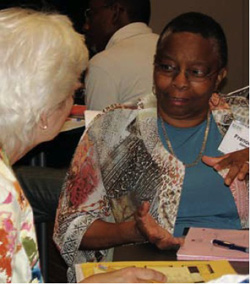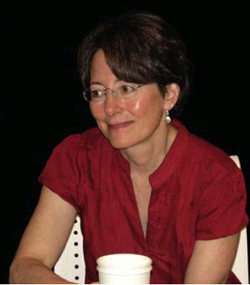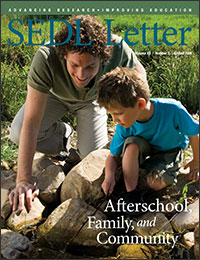Professional Development in the Afterschool Environment
The afterschool environment is diverse in program needs, instructor experience, and anticipated outcomes. According to a recent survey conducted by SEDL’s National Partnership for Quality Afterschool Learning at 54 promising afterschool sites around the country, 75% of afterschool instructors have a bachelor’s or master’s degree and 72% have at least 3 years of afterschool experience. These sites have demonstrated a positive effect on student achievement. There are approximately 8,000 other sites, however, that may not have the same level of resources and experience available. Professional development can have a large and lasting impact on these sites—if it is done correctly.
Select Afterschool Resources
National Staff Development Council www.nsdc.orgAfterschool Training Toolkit www.sedl.org/afterschool/toolkits
National Partnership for Quality Afterschool Learning www.sedl.org/afterschool
Promising Practices in Afterschool www.afterschool.org
Beyond the Bell www.beyondthebell.org
National Association of Elementary School Principals, Leading After-School Communities: What Principals Should Know and Be Able to Do www.naesp.org
High-quality professional development activities are intentionally designed to increase knowledge, skills, understanding, and/or performance. Research shows that “sit-and-get” sessions—where an audience patiently sits and listens to an instructor for a few hours one day—are not effective in changing instructor behavior, instructor attitudes, or student performance (NSDC, 2001). Because 21st Century Community Learning Centers (21st CCLCs) and other afterschool programs are often evaluated on the basis of student outcomes, high-quality professional development for afterschool professionals is becoming increasingly necessary.
“Professional development is much more than attending a conference once a year,” said Catherine Jordan, who directs the National Partnership for Quality Afterschool Learning. “Effective professional development is well-planned, systematic, job-embedded, and continuous and has intentional outcomes that advance the understanding and performance of program staff. It is essential to improving the overall afterschool environment.” Jordan explained this to more than 20 participants at a 3-day professional development workshop hosted by SEDL in June. The workshops, one of six that will be held throughout the summer and fall, are produced by the National Partnership for the U.S. Department of Education’s Technical Assistance and Professional Development program for 21st CCLCs.
SEDL staff, along with staff from Learning Point Associates and the SERVE Center at the University of North Carolina at Greensboro, presented the 3 days of training based on the National Partnerships’ Afterschool Training Toolkit, an online professional development tool. Developed over the past 4 years, the toolkit demonstrates how to use promising practices to build students’ academic skills through fun and engaging activities. Material in the toolkit is based on current afterschool and content-area research.

“The toolkit is awesome,” said Corinne Taylor, an evaluator at the New Mexico Public Education Department and a workshop participant. “The videos in the toolkit make the professional development real for my teachers and instructors.”
According to Deborah Donnelly, product coordinator for the National Partnership, the 20 videos produced for the toolkit provide the link between theory and practice that is often missing from other forms of professional development. As 21st CCLC site coordinators, directors, or instructors, participants will take what they learned at the workshop back to either their state or their program.
“We were able to apply what we learned about professional development during the first day and a half to working with the homework content within the toolkit,” said Frances Jones of the Region XII Technical Assistance Center in Weslaco, Texas. “This is going to help me integrate my staff development training into small, manageable sessions.”
One of the strategies discussed extensively at the workshop is the ability to provide high-quality professional development in 15-minute chunks at staff meetings and department meetings.
Staff Development 15 Minutes at a Time | |
| When it comes to professional development, one of the most common complaints from afterschool leaders is that they don’t have the time or money for training. While it may be tempting to abandon professional development, a well-trained staff can have greater success in offering activities that will improve student achievement. Instead of sending your staff to a conference, consider using free or inexpensive resources and devoting just 15 minutes a week during a staff meeting to professional development. What follows are examples of how you can use the Afterschool Training Toolkit for professional development on academic enrichment in afterschool. Each activity below can be done in 15 minutes. All you need is a computer with Internet access. | |
| Explore the Afterschool Training Toolkit. | Show your staff the toolkit at www.sedl.org/afterschool/ toolkits. The toolkit has six content areas: literacy, math, science, the arts, technology, and homework help. Each content area includes the following components: information about the role the subject plays in afterschool, promising practices, sample lessons, and resources and references. After your staff has spent some time exploring the toolkit, ask them to explain the components. |
| Learn about promising practices. | Promising practices are teaching techniques used in afterschool programs with evidence suggesting they help students learn important academic content. Watch a video demonstrating a promising practice with your staff and ask them to discuss what they saw. They can also spend some time reading about the practice on the Web site. Ask your staff how they can incorporate the practice into existing lessons. |
| Teach a lesson. | Ask your staff to select a sample lesson they would like to teach and discuss the parts of the lesson. Talk about what they need to implement it. Staff should teach the lesson to their students and be prepared to report back on their experiences. |
| Talk about what you learned. | Ask staff to give feedback on how their lessons went, what worked and didn’t work, and what they would do differently. Revisit the promising practice and parts of the lesson. Do their existing lessons have these components? What changes could they make to these lessons to make them more effective? |
| Reprinted from AfterWords, the newsletter of the National Partnership for Quality Afterschool Learning, which is funded by the U.S. Department of Education | |
“The toolkit allows instructors to learn teaching strategies, access lesson plans, and see for themselves how their instruction can change over time,” said Donnelly. “It is the driving force as to why we created the toolkit. We know how difficult it can be to schedule professional development that is developed specifically for afterschool professionals.”
Jordan agreed. “According to our research, frontline staff rarely have the opportunity to receive high-quality professional development. If instructors use the toolkit in a systematic way in small chunks, then we know that high-quality professional development is being provided,” she said.

Jackie Rudat of Indiana, and Frances Jones of Texas discuss their respective programs.

Corinne Taylor of the New Mexico Public Education Department participates in a discussion at the 3-day professional development workshop hosted by SEDL in June.
Providing professional development to afterschool professionals is an increasing trend that the National Staff Development Council (NSDC) embraces. Joellen Killion, NSDC deputy executive director, explained that now that afterschool programs are beginning to be linked to day-school programs, it is critical for afterschool professionals to understand the difference between afterschool and day-school curricula.
“We want to increase the capacity of our afterschool professionals in terms of academic outcomes, but we also want to ensure that the emotional, behavioral, social, physical, and creative aspects of children are developed and supported in afterschool settings,” Killion said. “No one wants to do more worksheets after the school day is over. Afterschool is a time for creative learning and enrichment, and that takes different skill sets.”
Another focal point of the workshop was demonstrating how all instructors, program directors, and professional development providers have opportunities to become leaders in their afterschool environments. This was one of the goals in creating the toolkit. Because the toolkit is online, any staff member can lead professional development sessions through facilitating discussions, presenting material, coaching, or consulting.
“Our mission for these professional development sessions is to really demonstrate how the toolkit can be used to provide afterschool practitioners with research-based professional development that enables them to increase their credibility with day-school programs while improving the academic performance of their students,” said Jordan.
Reference
- National Staff Development Council with the Southwest Educational Development Laboratory. (2001).
- Oxford, OH: NSDC.
Next Article: USDE's Parental Information and Resource Center (PIRC) Program Works to Boost Parent Involvement and Achievement

